B) False
Correct Answer

verified
Correct Answer
verified
Multiple Choice
In reality,perfect price discrimination is
A) used by about 75 percent of all monopolies.
B) used by about 50 percent of all monopolies.
C) seldom used by monopolies because it leads to lower profits.
D) rarely possible.
F) A) and D)
Correct Answer

verified
Correct Answer
verified
Multiple Choice
One problem with government operation of monopolies is that
A) a benevolent government is likely to be interested in generating profits for political gain.
B) monopolies typically have rising average costs.
C) the government typically has little incentive to reduce costs.
D) a government-regulated outcome will increase the profitability of the monopoly.
F) B) and D)
Correct Answer

verified
Correct Answer
verified
Multiple Choice
If government officials break a natural monopoly up into several smaller firms,then
A) competition will force firms to attain economic profits rather than accounting profits.
B) competition will force firms to produce surplus output,which drives up price.
C) the average costs of production will increase.
D) the average costs of production will decrease.
F) None of the above
Correct Answer

verified
Correct Answer
verified
True/False
A monopoly creates a deadweight loss to society because it earns both short-run and long-run positive economic profits.
B) False
Correct Answer

verified
Correct Answer
verified
Multiple Choice
Table 15-4
A monopolist faces the following demand curve:
 -Refer to Table 15-4.If the monopolist produces 5 units,what is its marginal revenue?
-Refer to Table 15-4.If the monopolist produces 5 units,what is its marginal revenue?
A) $100
B) $37.5
C) $15
D) $2.50
F) A) and D)
Correct Answer

verified
Correct Answer
verified
Multiple Choice
The amount that producers receive for a good minus their costs of producing it equals
A) quantity supplied.
B) supply price.
C) deadweight loss.
D) producer surplus.
F) A) and C)
Correct Answer

verified
Correct Answer
verified
Multiple Choice
Table 15-1
A monopolist faces the following demand curve:
 Marginal cost is constant at $8 per unit.
-Refer to Table 15-1.Suppose the firm depicted in the table is selling a prescription drug for which it had a patent,but the patent has expired.As new firms enter the market and sell the generic version of this drug competitively,what quantity will be sold?
Marginal cost is constant at $8 per unit.
-Refer to Table 15-1.Suppose the firm depicted in the table is selling a prescription drug for which it had a patent,but the patent has expired.As new firms enter the market and sell the generic version of this drug competitively,what quantity will be sold?
A) 3 units
B) 4 units
C) 5 units
D) 6 units
F) B) and D)
Correct Answer

verified
Correct Answer
verified
Multiple Choice
Table 15-10
The monopolist faces the following demand curve:
 -Refer to Table 15-10.If the monopolist has total fixed costs of $40 and a constant marginal cost of $5,what is the profit-maximizing level of output?
-Refer to Table 15-10.If the monopolist has total fixed costs of $40 and a constant marginal cost of $5,what is the profit-maximizing level of output?
A) 7 units
B) 16 units
C) 23 units
D) 31 units
F) B) and C)
Correct Answer

verified
Correct Answer
verified
True/False
At the profit-maximizing quantity of output for a monopolist,average revenue,marginal revenue,and price are all equal.
B) False
Correct Answer

verified
Correct Answer
verified
Multiple Choice
Which of the following can defeat the profit-maximizing strategy of price discrimination?
A) consumer surplus
B) deadweight loss
C) market power
D) arbitrage
F) A) and B)
Correct Answer

verified
Correct Answer
verified
Multiple Choice
Which of the following statements is not correct?
A) The government may use antitrust laws to break up an existing company to improve competition.
B) The government may break up a natural monopoly to lower the price charged to customers.
C) Private ownership is typically preferred to public ownership.
D) Sometimes the best strategy is for the government to do nothing about monopoly inefficiency because the "fix" may be worse than the problem.
F) A) and B)
Correct Answer

verified
Correct Answer
verified
Multiple Choice
Suppose a firm has a monopoly on the sale of a computer game and faces a downward-sloping demand curve.When selling the 50th game,the firm will always receive
A) less marginal revenue on the 50th game than it received on the 49th game.
B) more average revenue on the 50th game than it received on the 49th game.
C) more total revenue on the 50 game than it received on the first 49 game.
D) Both b and c are correct.
F) All of the above
Correct Answer

verified
Correct Answer
verified
Multiple Choice
Figure 15-2 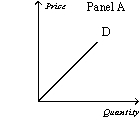
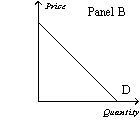
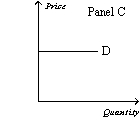
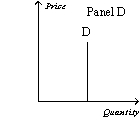 -Refer to Figure 15-2.Which of the following statements is correct?
-Refer to Figure 15-2.Which of the following statements is correct?
A) Panel C represents the typical demand curve for a perfectly competitive firm,and Panel B represents the typical demand curve for a monopoly.
B) Panel B represents the typical demand curve for a perfectly competitive firm,and Panel C represents the typical demand curve for a monopoly.
C) Panel A represents the typical demand curve for a perfectly competitive firm,and Panel B represents the typical demand curve for a monopoly.
D) Panel C represents the typical demand curve for a perfectly competitive firm,and Panel D represents the typical demand curve for a monopoly.
F) A) and B)
Correct Answer

verified
Correct Answer
verified
Multiple Choice
A monopolist's profits with price discrimination will be
A) lower than if the firm charged a single,profit-maximizing price
B) the same as if the firm charged a single,profit-maximizing price.
C) higher than if the firm charged just one price because the firm will capture more consumer surplus.
D) higher than if the firm charged a single price because the costs of selling the good will be lower.
F) C) and D)
Correct Answer

verified
Correct Answer
verified
True/False
By selling hardcover books to die-hard fans and paperback books to less enthusiastic readers,the publisher is able to price discriminate and raise its profits.
B) False
Correct Answer

verified
Correct Answer
verified
Multiple Choice
Amanda inherited the only local cable TV company in town after her father passed away.The company is completely unregulated by the government and is therefore free to operate as it wishes.Assume that Amanda understands the true power of her new monopoly.Which of the following statements is (are) correct? (i) She will be able to set the price of cable TV service at whatever level she wishes. (ii) The customers will be forced to purchase cable TV service at whatever price she wants to set. (iii) She will be able to achieve any profit level that she desires.
A) (i) only
B) (ii) only
C) (i) and (iii) only
D) (i) , (ii) ,and (iii)
F) A) and B)
Correct Answer

verified
Correct Answer
verified
Multiple Choice
Figure 15-16 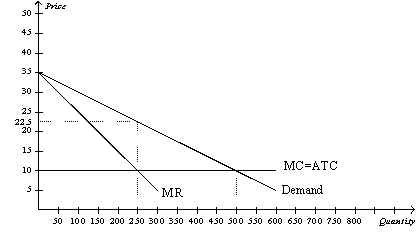 -Refer to Figure 15-16.If the monopoly firm perfectly price discriminates,then the deadweight loss amounts to
-Refer to Figure 15-16.If the monopoly firm perfectly price discriminates,then the deadweight loss amounts to
A) $0.
B) $1,562.50.
C) $3,125.
D) $6,250.
F) All of the above
Correct Answer

verified
Correct Answer
verified
Multiple Choice
Most markets are not monopolies in the real world because
A) firms usually face downward-sloping demand curves.
B) supply curves slope upward.
C) firms usually equate price with marginal cost.
D) there are reasonable substitutes for most goods.
F) A) and B)
Correct Answer

verified
Correct Answer
verified
Multiple Choice
Table 15-1
A monopolist faces the following demand curve:
 Marginal cost is constant at $8 per unit.
-Refer to Table 15-1.The monopolist's total revenue from selling 4 units of output is
Marginal cost is constant at $8 per unit.
-Refer to Table 15-1.The monopolist's total revenue from selling 4 units of output is
A) $4.
B) $16.
C) $32.
D) $48.
F) C) and D)
Correct Answer

verified
Correct Answer
verified
Showing 461 - 480 of 541
Related Exams